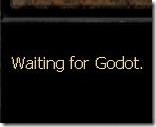 With replays down for another week due to…typo (*facepalm*)…I have to put off the conclusion of last week’s ACR draft. Highly annoying, since finishing up the ACR draft this week would have set me up nicely to dive into some M10 drafting next week. Instead, with my second audible in as many weeks, M10 moves up in the queue courtesy of the prerelease, which I will use to demonstrate some technical tricks for building a sealed deck on Magic Online.
With replays down for another week due to…typo (*facepalm*)…I have to put off the conclusion of last week’s ACR draft. Highly annoying, since finishing up the ACR draft this week would have set me up nicely to dive into some M10 drafting next week. Instead, with my second audible in as many weeks, M10 moves up in the queue courtesy of the prerelease, which I will use to demonstrate some technical tricks for building a sealed deck on Magic Online.
Sealed has a reputation for being more luck-intensive than draft. There is some truth to that, particularly in core-set sealed, which has traditionally been a bomb-driven format. If you open, play with, and resolve better bombs than your opponent, you are generally going to win more often. Draft certainly has a similar element of luck, though. It doesn't take a world-class player, after all, to first-pick (Elspeth, Knight-Errant), follow her trail for the rest of the draft, and then win all of the games where she resolves any more than it does to open her in a sealed pool and do the same.
I don’t think sealed is as much “luckier” than draft as it is a test of different skills. Drafting asks you to read signals and make some tough picks, but the resulting deck mostly builds itself. If you’re lucky, you have 23-27 playables, 20 are no-brainer inclusions, and you just have to pick your final few main-deck cards from the leftovers and set your mana base.
Sealed challenges you to come up with an optimal build for a sprawling card pool with strengths spread out over all colors. This is an under-appreciated limited skill, particularly by those who spend most of their limited Magic time in the draft queues. I've actually spent most of my time on Magic Online over the years in leagues, so I have spent a great deal of time honing that skill (which could be part of the reason I see it as under-appreciated).
Unfortunately, that skill has atrophied significantly since the launch of 3.0 and the demise of leagues. I only play sealed for prereleases now, and not only am I a bit rusty at building the perfect sealed deck, there is a major difference between making a sealed deck for a league and making a sealed deck for a prerelease: the clock.
With leagues, you had the luxury of functionally limitless time. You could ponder your pool for a while, throw together a few different builds, test-draw them and test-play them repeatedly before finally deciding which version to take into battle, with your alternate builds a quick sideboard load away. You could even wait a week to play if you felt—as I often did—that your initial pool was one decent booster pack away from being great, and that it was better to wait.
Not so with the sealed events currently available on Magic Online. Until the return of leagues, if you are playing online sealed, you have twenty minutes to come up with your build. Particularly when faced with a new set, those can be twenty harrowing minutes that fly by all too fast. Here are the steps I use when building an online sealed deck to make the most of my ticking clock.
Step One: The Rare Check
The first thing I do with any sealed pool is the rarity sort (right-clicking in the editor field presents you with various sorting options). Not only is it like opening a birthday present to check your rares, it’s also good to start by looking for any rare bombs that might influence your upcoming color decisions. Since most people check their rares instinctively anyway this is no hidden gem of sealed-deck wisdom, but it’s good to reinforce that the move is correct from a deck-building standpoint and not just a present-opening standpoint.
I’m not going to break down the full building process for all three of my prerelease decks, but I’ll show all the rare checks, because who doesn’t like opening birthday presents?

M10 Prerelease #1 Rares
Nice! The biggest money rare this side of Baneslayer Angel in the Great Sable Stag, and two legitimate green bombs in Master of the Wild Hunt and Ant Queen. Before even looking at my commons or uncommons, it is almost a certainty that this pool will be base green based on those rares alone. Print runs will ensure that I get some kind of green support for those bombs. The Rootbound Crag makes me hope red is a good splash or secondary color. Next!
 M10 Prerelease #2 Rares
M10 Prerelease #2 Rares
Rare check #2 reveals a couple of good black cards in Vampire Nocturnus and Cemetery Reaper, but Vampire Nocturnus in particular is very black, requiring a heavy commitment to swamps and black cards in the deck to be good, and a vampire supporting cast to be great. The reaper is not so particular—he’ll happily buff any zombies I happen to have, but he’ll make his own if I'm fresh out. If the removal and depth is there to support black, great, but these rares do not force black in quite the same way the rares from #1 force green.
The Sphinx Ambassador is also a compass card that could point me in the blue direction, but the Goblin Chieftain needs a significant playable goblin count before it could be construed as a bomb. Next!
 M10 Prerelease #3 Rares
M10 Prerelease #3 Rares
(Shivan Dragon) is a strong red indicator, and double Djinn of Wishes almost immediately puts me into blue. Maybe I can flip djinn #2 off of djinn #1 and pull off the classic genie-in-the-lamp exploit: wish for more wishes! (Ball Lightning) is a nice pull for secondary-market value, but it’s not great pull for the sealed deck. In constructed, four (Ball Lightning)s are in mono red decks built around smacking the opponent silly with hyper-efficient mana-to-damage ratios before they can mount a defense. In limited—sealed especially—you won’t have mono red, and you won’t have that kind of overall efficiency in your spells. The great ball of fire is playable, but it will operate like a blockable (Lava Axe) in a two-color limited deck.
I’m three for three on Sanguine Bond, which would need more life gain than most sealed decks will ever have to offer to become playable. Hopefully the equally-unplayable Darksteel Colossus will fetch a few tickets in the trade room. Elvish Archdruid should fetch more than a few, but, like Goblin Chieftain, his playability will depend entirely upon the creature count in the tribe he supports.
Step Two: Weed Your Colors
Now it’s time to put the card pool into the view I generally use for the rest of deckbuilding: sort by converted mana cost. At first, this view produces an overwhelming jumble of cards, so quickly narrow down the view by right-clicking a filter to show only cards of that type. I always start with “colorless” so I can see what relevant fixing or “any deck” cards I might have, which in this case is a (Terramorphic Expanse) and a Rod of Ruin. The rod is nothing great (seven mana spent before you’ve done one point of damage?), but it’s good to know I have an expanse in the pool as I head into the color weed.
If my rares have a strong lean towards a color, I’ll usually check that color for support next. In the case of my first pool, green has bomb rares I definitely want to play, so I start there:
 Now that I've sorted by mana cost and filtered by color, my method becomes a little counterintuitive: I put all of the unplayables and cards that I would only play with the right circumstances into the main deck. This is because the filters only affect sideboard cards, and I want to filter the pool of cards I might actually play.
Now that I've sorted by mana cost and filtered by color, my method becomes a little counterintuitive: I put all of the unplayables and cards that I would only play with the right circumstances into the main deck. This is because the filters only affect sideboard cards, and I want to filter the pool of cards I might actually play.
In this case, I banish (Fog), Regenerate, the two Oakenforms, the Bountiful Harvest, and the Enormous Baloth to the main deck. Windstorm should arguably be in that category, but there are definitely some fuzzy lines in this process. The important thing is to move the cards you would never play under any circumstance into the main deck and out of sight. What standards you apply to your weeding beyond that depend on what density of quality you want to be browsing when you are done.
Some would happily keep the Oakenforms with the playables, for example. Unanswered, an Oakenformed creature is a beast. Answered, though, and it’s a two-for-one. I like to bring in Oakenform-type enchantments when my opponent has shown a lack of the removal that would punish me for running them, but I like to start them in the board if I can.
Sadly, I don’t have the density of solid green commons and uncommons I would like to see to support my bombs, but that’s the way it goes. Green is still a front runner despite this because of the bomb-driven-format factor, and that may inform my decisions about which cards to discard into the main deck for the other colors. Next up is white:
 (Serra Angel) leaps out right away, as do (Pacifism), Harm’s Way, and (Armored Ascension). I move Solemn Offering, Angel’s Mercy, Mesa Enchantress, and the two Siege Mastodons into the main deck. In retrospect, the mastodons are serviceable enough to have kept in the sideboard with the other playables.
(Serra Angel) leaps out right away, as do (Pacifism), Harm’s Way, and (Armored Ascension). I move Solemn Offering, Angel’s Mercy, Mesa Enchantress, and the two Siege Mastodons into the main deck. In retrospect, the mastodons are serviceable enough to have kept in the sideboard with the other playables.
Erroneously thinking they were essentially re-flavored (Spirit Link)s, I left the Lifelinks in with the playables. (Spirit Link) was playable in limited decks that inevitably won through the air. In such decks, (Spirit Link) functioned as a quasi-(Pacifism) on opposing ground creatures, because the "you" referenced by (Spirit Link) was still its caster, even when cast on an opponent's creature. Every non-lethal attack by the (Spirit Link)ed creature was nullified by the resulting life gain.
Lifelink, however, actually gives the enchanted creature lifelink, stripping the card of the tricky uses its predecessor (Spirit Link) enjoyed. It's an example of the subtle changes R&D has made to M10’s nigh-functional reprints to strip them of unintuitive abilities and enhance flavor. Lifelink is really what they meant by (Spirit Link) all along, and I'm fine with the correction—unfortunately, it renders Lifelink entirely unplayable in limited.
Whatcha got, blue?
 Blue is not particularly deep, but it has some very tempting cards. First off, I exile the Tome Scour, (Telepathy), and, in a close call, Zephyr Sprite, but everything else stays. Paired with green beef and wolf and ant tokens, Sleep can frequently end games with the effectiveness of (Overrun) by setting up two unopposed swings. (Merfolk Looter) is extremely powerful in a format where you win by finding your bombs first, and where there’s generally a huge power gap between your quality cards and your filler.
Blue is not particularly deep, but it has some very tempting cards. First off, I exile the Tome Scour, (Telepathy), and, in a close call, Zephyr Sprite, but everything else stays. Paired with green beef and wolf and ant tokens, Sleep can frequently end games with the effectiveness of (Overrun) by setting up two unopposed swings. (Merfolk Looter) is extremely powerful in a format where you win by finding your bombs first, and where there’s generally a huge power gap between your quality cards and your filler.
The blue has some quality, but it is shallow enough that it will only be playable with green if I splash a third color, which fortunately this pool is capable of doing. What about black?
 I dump the Acolyte of Xathrid, the (Megrim), the Soul Bleed, the Sanguine Bond, and, questionably, the Zombie Goliath. His stats seemed so weak in the context of a base-green deck that I benched him, but, like the Siege Mastodon, he is playable, if boring and overcosted. (Deathmark) and (Duress) are both gray-area cards. I’d prefer to start both on the bench, but both could make the cut in a pinch, too. I moved (Duress) to the main deck and kept (Deathmark) with the playables, but I’d reverse that with a do-over.
I dump the Acolyte of Xathrid, the (Megrim), the Soul Bleed, the Sanguine Bond, and, questionably, the Zombie Goliath. His stats seemed so weak in the context of a base-green deck that I benched him, but, like the Siege Mastodon, he is playable, if boring and overcosted. (Deathmark) and (Duress) are both gray-area cards. I’d prefer to start both on the bench, but both could make the cut in a pinch, too. I moved (Duress) to the main deck and kept (Deathmark) with the playables, but I’d reverse that with a do-over.
The black is solid and has a low curve, but it’s noticeably missing the all-important Doom Blade. A single Tendrils of Corruption, a single (Assassinate), and a (Deathmark) are not exactly the removal suite you hope to see from your black after cracking six packs, but the low curve is appealing. On to red…
 With double (Lightning Bolt), (Pyroclasm), and Rootbound Crag, at least splashing red is a certainty. I ship the non-bolt one drops, the (Shatter), and the (Panic Attack)s to the main deck. With only the Seismic Strike and the (Dragon Whelp) pushing hard for more Mountains, my feeling is that red won’t be more than a splash, but now that I’ve trimmed the fat from all five colors, I can really take a look.
With double (Lightning Bolt), (Pyroclasm), and Rootbound Crag, at least splashing red is a certainty. I ship the non-bolt one drops, the (Shatter), and the (Panic Attack)s to the main deck. With only the Seismic Strike and the (Dragon Whelp) pushing hard for more Mountains, my feeling is that red won’t be more than a splash, but now that I’ve trimmed the fat from all five colors, I can really take a look.
Step Three: Use Your Filters
With the unplayables out of the sideboard and the cards sorted by cost, I can toggle the filters to explore what different combinations of colors would look like as a deck core. Since I know I want to build around my green bombs, this amounts to taking a look at green in combination with the other four colors:
Pretend those Lifelinks aren’t there and the two Siege Mastodons are, mmmmkay? (Serra Angel), (Pacifism), Harm’s Way, and (Armored Ascension) continue to impress, but the rest of the white is all very shallow and meh. “Meh” is acceptable if the cream is exceptional, though, and there’s no question the top four white cards are excellent, subtly providing as much main-deck removal as black would.
(mana=g)(mana=u) looks shallow but promising. I haven’t played a single spell from M10 yet, but all my instincts and experience tell me that Sleep will end games, and in particular stalled-out games, which core sets are known for. The falter option is one of the things that makes (Naya Charm) and (Cryptic Command) tournament-worthy, and Sleep does that twice! On offense, at any rate. If forced to play it defensively, Sleep is only keeping The Man down for one attack. With red providing some removal, I like the potential, here. Black provides the best curve enhancement of the bunch. Vampire Aristocrat has great synergy with my token-making bombs, and it adds some removal to the mix, even if it’s not black’s finest. What is does not do is help me end games like (Serra Angel), (Armored Ascension), and double Sleep do. If that’s the job description of Master of the Wild Hunt and Ant Queen, though, this is not a major knock against black. A major contender for second chair.
Black provides the best curve enhancement of the bunch. Vampire Aristocrat has great synergy with my token-making bombs, and it adds some removal to the mix, even if it’s not black’s finest. What is does not do is help me end games like (Serra Angel), (Armored Ascension), and double Sleep do. If that’s the job description of Master of the Wild Hunt and Ant Queen, though, this is not a major knock against black. A major contender for second chair.
There are only 18 cards here, and none of the other colors splash as well as red does. At this point, I send all the color-intensive red to the main deck so I can leave red on to be viewed as a splash color. This narrows down the options to GUr, GBr, and GWr, and I could make a case for running each of them. This is why sealed deck is so tough! Deckbuilding is never this hard in a draft.
In the end, I was seduced by the door-slamming power of Sleep and the virtual card advantage of (Merfolk Looter), and I ran green-blue splash red, for this list:
 To get your chaff out of the main deck using this system, just right-click and “select all” in the main deck area. Drag off to the far right of the sideboard, and all the chaff cards will stack in a single pile. Then click and drag to highlight the chosen main-deck combination and drag them into the main deck. Tweak from there and add your mana base.
To get your chaff out of the main deck using this system, just right-click and “select all” in the main deck area. Drag off to the far right of the sideboard, and all the chaff cards will stack in a single pile. Then click and drag to highlight the chosen main-deck combination and drag them into the main deck. Tweak from there and add your mana base.
I submitted my deck still uncertain as to whether or not I had the correct build. Had this been a league, I would have dwelled on the different build options for quite a while before settling, and even then I’d have all three options ready. Walking myself through my own process now, I’m leaning back towards the black option. It gives me the tools to make it to my game-winners even if it doesn’t add any, and if my opponent’s removal is black and/or red, I can bring in an Oakenform or two for a potentially fearsome Child of Night. That build would have looked something like this:
 The Matches
The Matches
Whether or not it was the optimal build, the GUr build had some excellent things going for it, and was certainly capable of a 3-1 run. After winning round one handily in two quick games and feeling confident, I finished a shameful 0-3 from there, although to be fair, in my three losses I was simply out-bombed.
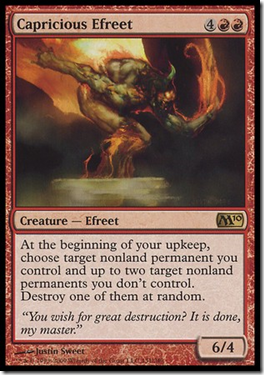
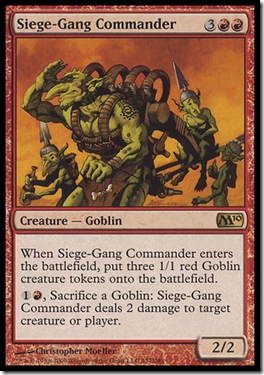
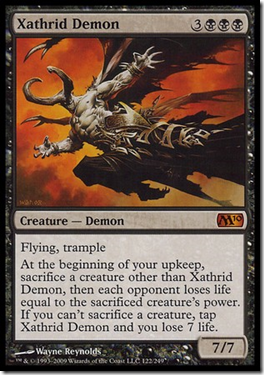
In round two, (Siege-Gang Commander) combined with the way-better-than-I-thought Capricious Efreet to utterly crush me. Besides having the odds 2-1 in your favor for a positive outcome with the efreet in play, the major factor that pushes him into bomb territory is that you pick all of the targets. That means there is a 66% chance your opponent will lose one of their best two non-land permanents, and a 33% chance that you will lose your worst. Those are game-winning odds, especially when you have cards like (Siege-Gang Commander) and (Elvish Visionary) generating fodder like my opponent did.
In round three, black removal cut down my bombs, and Villain cast Xathrid Demon in all three games. I won the one where I had (Cancel) waiting. Do you know what happens when (Lord of the Pit)’s little brother shows up across the table for a mana cheaper, and he flings creatures at your face instead of simply eating them, right before swinging at you for 7 points of flying trample damage? You lose. Quickly.
I figured I would take round four handily and get my pack. I mean some other 1-2 player couldn’t possibly be a match for me and my green bombs, right? Here are a few of the cards he ran out there:
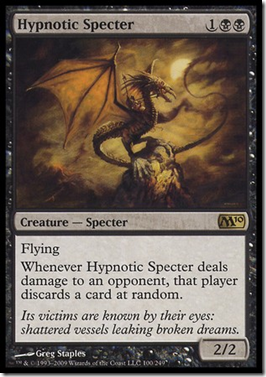
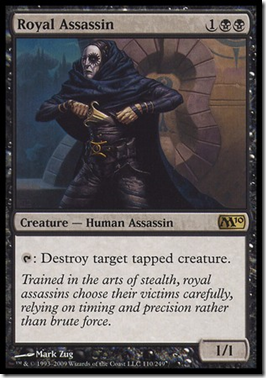
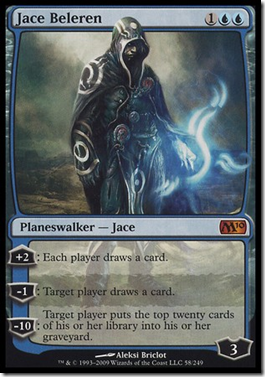
I mulled to five in game one, and even my turn-three Great Sable Stag wasn’t enough to race his turn-three Illusionary Servant and turn-four (Hypnotic Specter). My Master of the Wild Hunt took over and won game two, but Jace returned the favor in game three. Jace gave me cards but Villain removal and defenders, and suddenly I was firing (Lightning Bolt)s at Jace just to prevent his ultimate from decking me. I finally ran out of ways to contain the planeswalker and lost the match without a library.
It didn’t get much better for me in the next two flights. I ran a black-blue deck the second pool and a took it to a 2-2 record, but slipped back to 1-3 during a mulligan-plagued run in the third flight, in which I mixed it up between a blue-red build and a green-blue build splashing red for a (Fireball), which I never drew in four matches. Not the prerelease of my dreams, but the chase rares I pulled helped take the sting out of my lousy record, and I had fun diving headfirst into the new set.
Whether I submitted the right deck and had some bad luck, or I submitted the wrong deck and compounded it with bad luck, one thing is for certain: it is difficult to find the optimal build for a sealed deck in twenty minutes allotted. You might not find “optimal” every time, but I find the search is made much easier by applying the filtering technique I demonstrated today. Give it a try the next time you are searching for clarity in a sealed pool with the clock ticking down.

